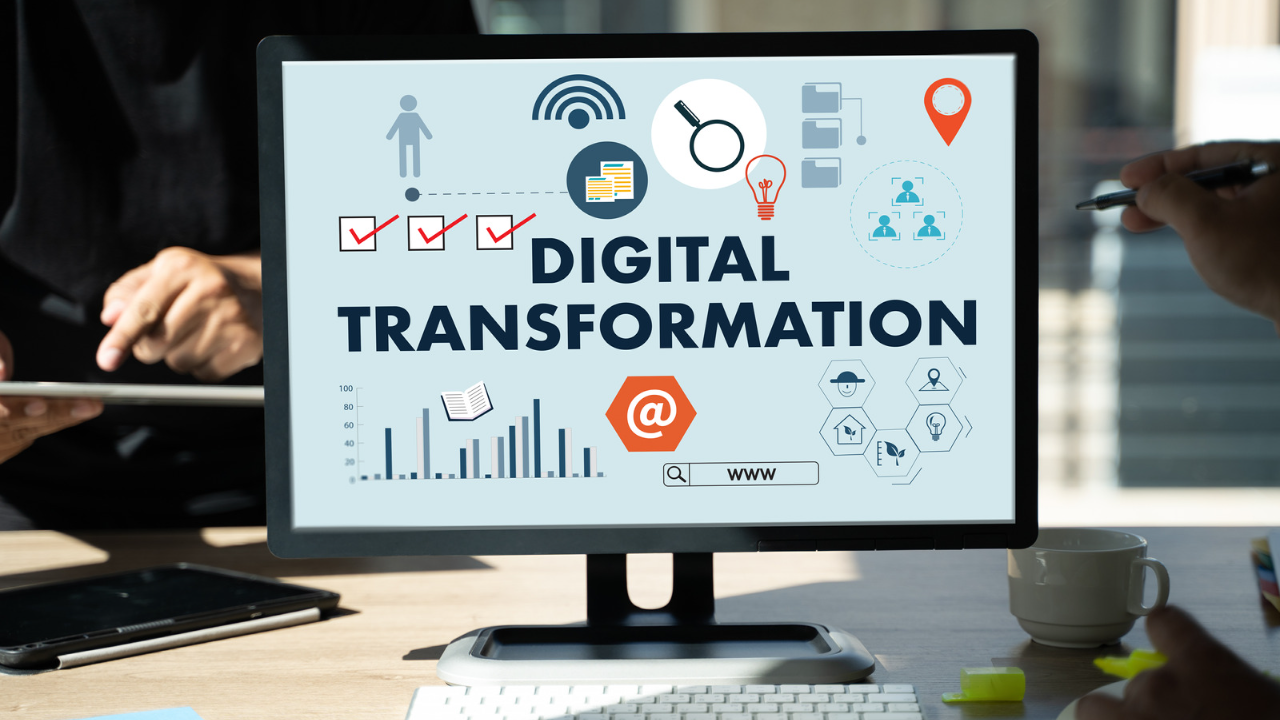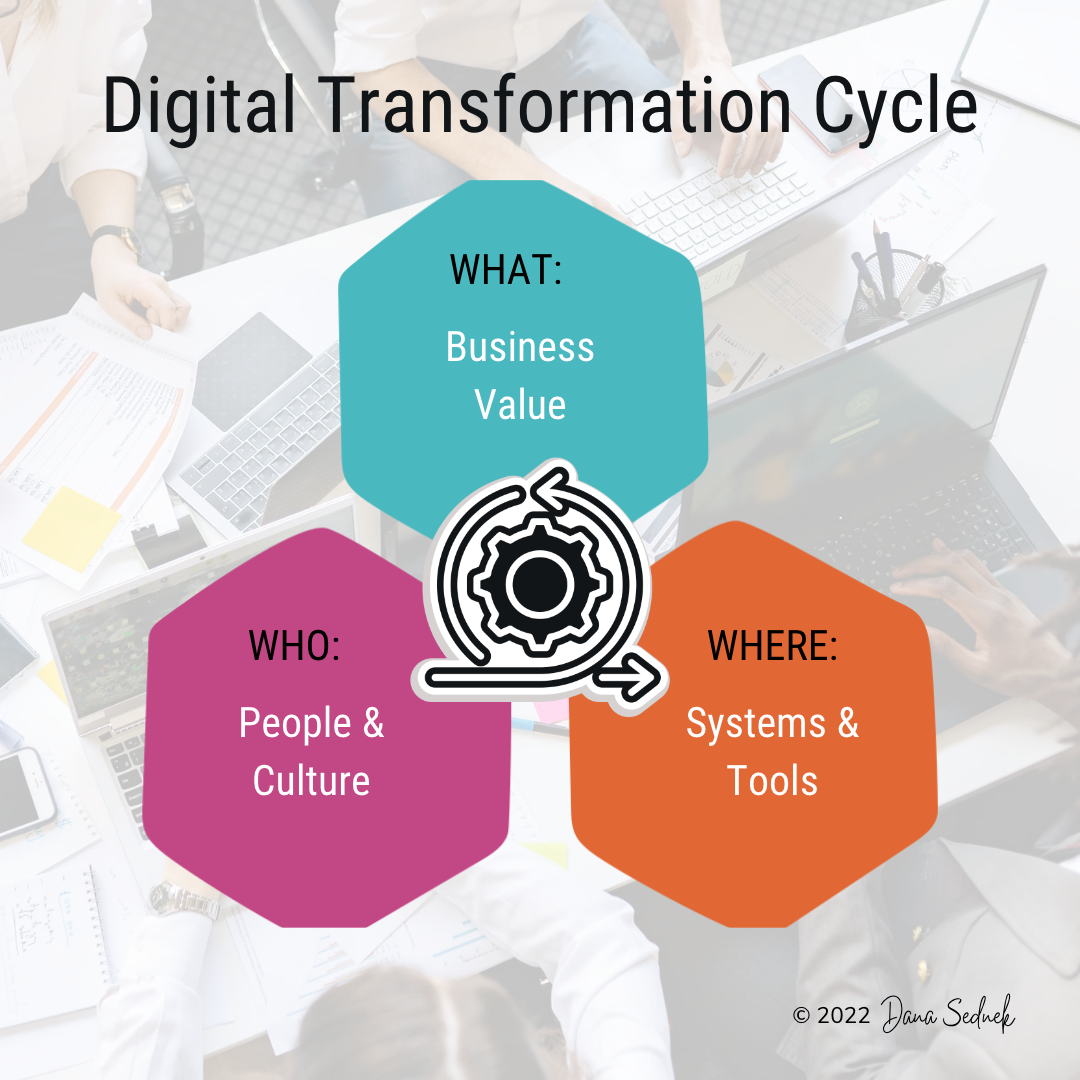Digital Transformation: Why Change What Isn't Broken?

Digital Transformation: Why Change?
For the past few years, we’ve heard the term “digital transformation” everywhere: in the media, at conferences, and in conversations with colleagues. At home, we’re offered “in the cloud” solutions that make our lives easier, faster or better. Heck, even my new dryer promises the possibility to keep my clothes from wrinkling remotely, with the push of a button “from the cloud”.
Digital transformation is a buzzword that’s everywhere, but what does it really mean? How do you know if your organization or team is ready to or is already digitally transforming?
Digital transformation is an ongoing exercise in business improvement that builds optimization, modernization, and innovation across three areas of your business:
- transforming your business model to add new and untapped value in the modern marketplace
- investing in systems and tools that change the way that value is delivered to the customer
- evolving the people and culture that delivers that value directly to the customer
Sometimes momentum achieved can be incremental. Other times, it might be disruptive or downright revolutionary. According to Gartner, it takes an average of 3 years for organizations to complete their first digital transformation project and 5 years for the majority of them to reach full maturity. Digital transformation is a journey. Sometimes it’s hard to know where to get started.
Let’s take this time to consider a framework of the digital transformation cycle and identify fears that hold us back from jumping in. I’ll also offer one small step you can take to begin to embark and/or accelerate your digital transformation journey. As a bonus, I’ll also include recommendations.
TL; dr: Listen. To what your customers, systems, and employees are telling you about what is no longer working for them.
The Digital Transformation Cycle

Think of the digital transformation cycle as the WHAT, WHERE, and WHO for modernizing your business:
- WHAT: The business value that is defined by your customer.
- WHERE: The systems and tools that enable you to deliver that business value to the customer.
- WHO: The people and culture that differentiate your business value from others in the market.
The cycle applies to internal teams of big organizations who deliver value to internal customers as well as small businesses that deliver products and services direct-to-consumer, and anywhere amongst and in-between.
The cycle involves small steps and large scale, sometimes disruptive, investments over time. At any given point, large or small, we’re often overcome with the fear that if we change a few things in one area, we will make a mess of the others.
Small changes do have rolling impacts along the cycle, yet they also build momentum towards the desired outcome you, your customers, and your employees want out of the process.
Even one digital change in one area of the cycle can have rolling impacts on the other two. This is a good thing because each area of digital transformation impacts the momentum of change, to create a flywheel effect.
Changes and Worries Along the Digital Transformation Cycle
Business Model Changes
FEAR: We don’t want to lose our customers.
Ultimately, it's your customer (internal or otherwise) who determines the value you deliver. It’s hard to let go of what has worked in the past, yet customer demand is evolving at the most rapid pace, ever seen. Customers these days expect you to listen to them. They expect you to know the pain points they experience and the delights that keep them coming back.
With so many startups popping up to solve problems or deliver solutions differently, the marketplace is offering better, faster, or quicker ways to get what your customer’s used to get from you.
Digital transformation helps your business evolve to deliver value for modern customer demands.
SMALL STEP: Listen to your customers, they determine your value.
What are your customers telling you now? Do they have a mechanism to be heard?
Do you know what your customers are wishing for? What are the opportunities you’re missing out on because your current business model can’t support it?
RECOMMENDATION: Provide a direct, modern outlet for customer listening.
This input gives you insight into how well-received your brand is in today’s marketplace, and ideas for how to evolve your business model to accommodate modern needs.
Systems and Tools Improvements
FEAR: Change is hard; Why change what isn’t broken?
Change is hard. It’s an iterative process that sometimes gets stuck on re-do over and over. Especially if we’re familiar with our tools and systems that tend to get the job done just fine.
If you’re like most people, your business systems - including processes and tools - are already working well for you- and they may have been doing so for years or even decades. But as the world changes around us, those systems have become less and less effective at doing what one might call “business as usual.” Business is no longer usual.
Fluidity, integration, and automation of your systems and tools can rapidly increase performance and revenue.
SMALL STEP: Listen to rattlesnakes in the system.
You might even feel tension or conflict in some of the ways you wish those systems could work better for your organization. They often recur as pain points that are often turned into “work arounds”. I like to call these rattlesnakes in the system.
These pain points are warning you of the opportunity ahead - and what might happen if you keep advancing in the same way you always have, without resolving, innovating, or improving the way you operate.
RECOMMENDATION: Build a list of pain points that recur in your systems and tools.
These should be easy to identify because they either result in complicated or outside work-arounds and/or cause a high amount of employee frustration. These pain points often feel like there is no seemingly clear solution or fix to them. Then build a list of what your organization wishes the systems and tools could do.
People and Culture
FEAR: Our People will resist AND our culture will erode.
It’s natural to resist change, especially when you embark on improving your operations.
People may resist it because they're afraid of losing their jobs or being made redundant by new technology. Some people don’t (yet) have the skills to make the change and might not understand what learning is necessary to get there.
Fortunately, your company culture can help guide you and set the path for a possible new future that employees can see themselves in. Culture is the very thing that can help move employee resistance to change.
SMALL STEP: Identify disconnects between company culture and the employee experience that exist today.
Listen to employee problems, pains, and wishes. The people closest to the work are the most wise about what is broken or getting in the way of the best possible work.
RECOMMENDATION: Evaluate those problems against what your company and culture values most.
When there is a disconnect, there is an opportunity to strengthen both culture AND employee experience.
Conclusion
There is no doubt that every organization or team is at a different point in its digital transformation journey, but ongoing education and assessment of your current roadblocks, capabilities, and opportunities will increase your potential for success.
An effective digital transformation strategy requires clear leadership from the CEO, board or other governing body, ongoing education and assessment of your current capabilities, and a clear vision of what you want to achieve. Having all three elements in place can help you stay on track as you transform into a more agile organization.
For example, if you have no clear vision for where you want to go, it’s difficult to determine which steps are necessary on the path toward getting there. Similarly, if there is no consensus among key stakeholders about what needs to be done or who has decision-making authority over certain aspects of the process, it becomes difficult (if not impossible) to get things done efficiently and effectively.
It’s time to embrace the change - find the courage to fix and improve areas of your business that aren't exactly broken - and leverage the digital leadership skills necessary to keep moving forward through the digital transformation cycle.

